story – Christopher Hector photos – Roslyn Neave
I’m trying to remember exactly when it was, more than ten years ago, that Christoph Hess told me he hoped that Young Horse classes could be the saving of Grand Prix competition. This was around the time when the Dutch had somehow hypnotized an otherwise perfectly sensible of collection international judges, that a horse lathered white muck sweat, that could not halt at either the beginning nor the end of its test, that cantered croup high, and got even higher in the changes, that lifted its front legs about a metre higher than its hind legs in the extended trot, that looked totally put upon, was indeed the number one dressage horse in the world – so much so that a gathering of experts at Joep Bartels’ 2004 Dressage Symposium (in Holland!) declared that Salinero was ‘the happiest horse in the world’. German ace, Ulla Salzageber retorted that the only reason Salinero was happy in the dressage arena was that Sjef couldn’t get near him…
Now to hear them talk, those judges, many of whom still linger on the scene, always thought the tension awful and always wanted harmony and lightness, it couldn’t have been them rewarding tension with gold medals could it?
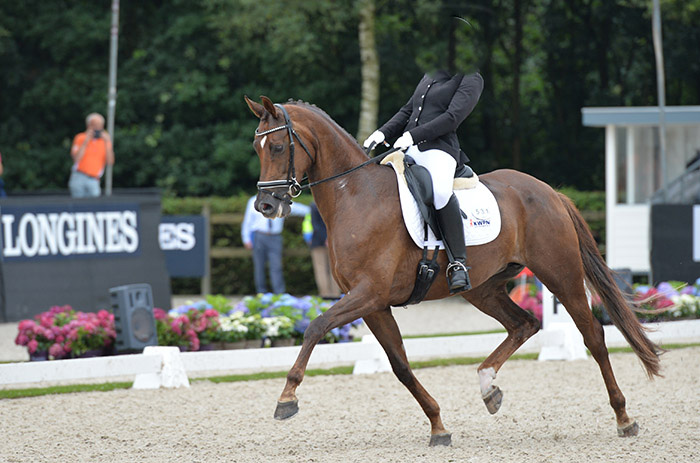
The old style was still alive at the 2017 World Young Horse Championships…
But has Christoph’s prediction come true? He suggested that the emphasis on the basic paces at the heart of the young horse classes, would force judges to look with keener eyes at a natural way of going… Was he right? Yes and no. Certainly many of the earlier Young Horse classes had their share of unpleasantly ‘spectacular’ performances. That horrible auction riding, the rider leaning back, sitting into the poor horse’s back to drive it even more wildly forward into pulling-back hands, was a hallmark of many a Bundeschampionate, Parvo, or even World Young Horse Championship winner, and was still on display at the most recent World Champs, although this style of riding is definitely in the minority these days.
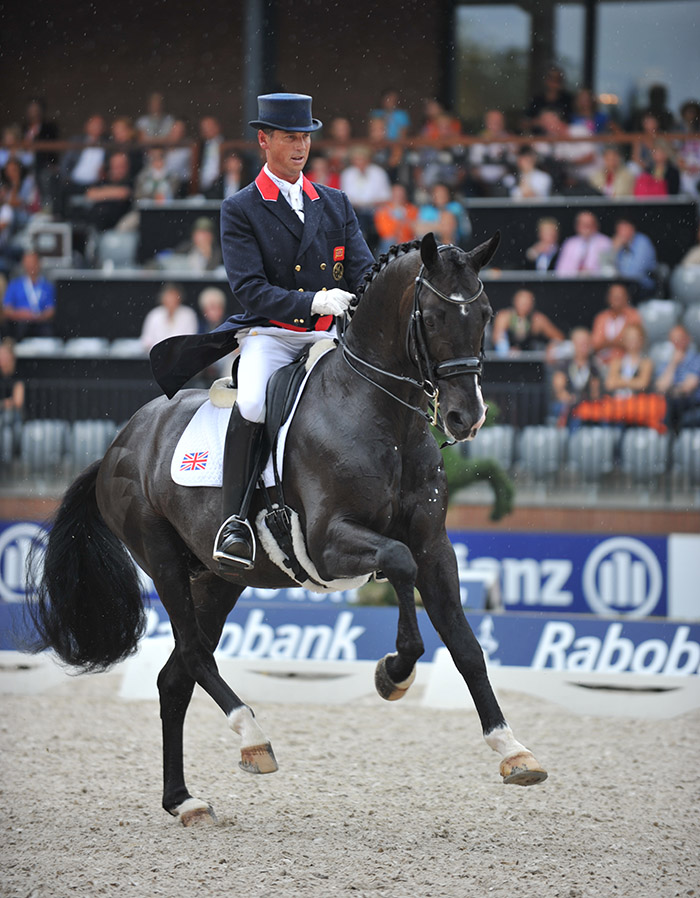
Carl Hester and Uthopia at the Rotterdam European Championships in 2011
Reform came perhaps a little earlier in the Young Horse classes before the Grand Prix world was turned on its head at the 2011 European Championships in Rotterdam, when the Brits unveiled the power of harmony, with a gold medal winning team led by Carl Hester and Uthopia and Charlotte Dujardin and Valegro, but young horse classes are still an important testing ground for whether the sport is headed in the right direction or not.
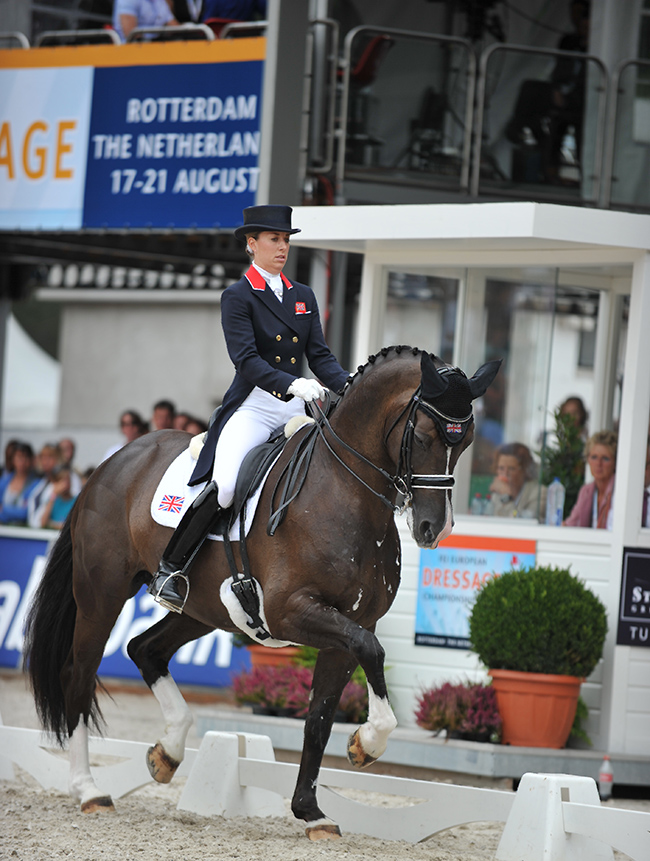
Charlotte and Valegro, their first European Championships
Judging Young Horse Classes with Francis Verbeek and Susie Hoevenaars
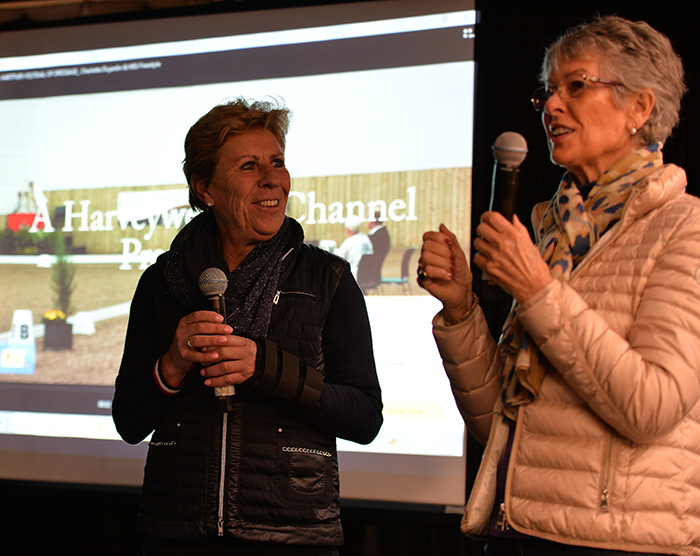
Susie Hoevenaars and Francis Verbeek are two judges at the cutting edge of international young horse competition, and while they were in Melbourne to judge the PSI Young Horse championships, after the competition, they conducted a seminar for riders and judges on young horse judging. Share their words of wisdom…
Right from the start, the duo stressed the need for the horses to go naturally, “we must recognize the quality and natural way of going, that is most important,” Susie told us.
Francis suggested that we look for the horse that “is really swinging over the back with a soft connection to the hands. The more easy it looks, the better it is. If you see the rider working their hands and legs, that means there is not the right balance between the rider and the horse…”
A winner at the 2017 World Young Horse Championships, Don Martillo demonstrates:
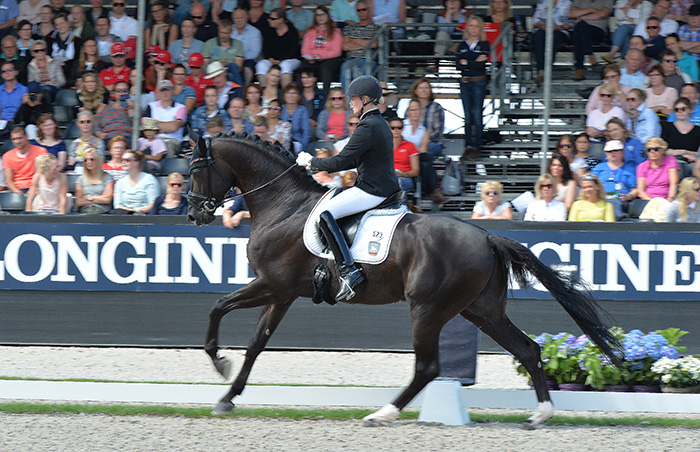

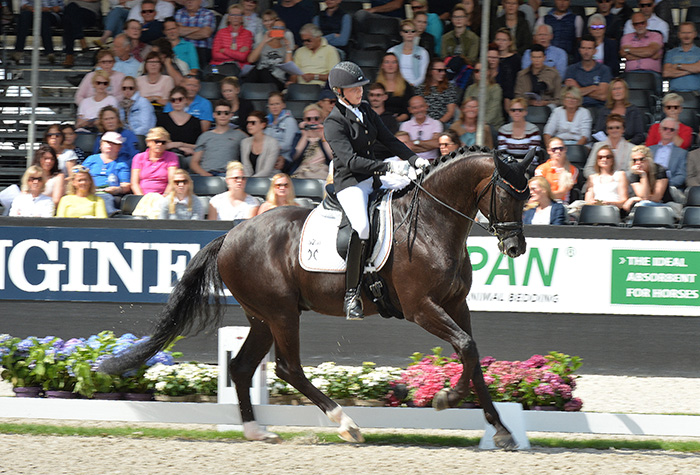
“Ease is what we look for, not the rider supporting the horse. I judged Zonik three years ago in Prix St Georges and it was oh so beautiful. I gave 80% the first time, when you see quality, give big scores.”
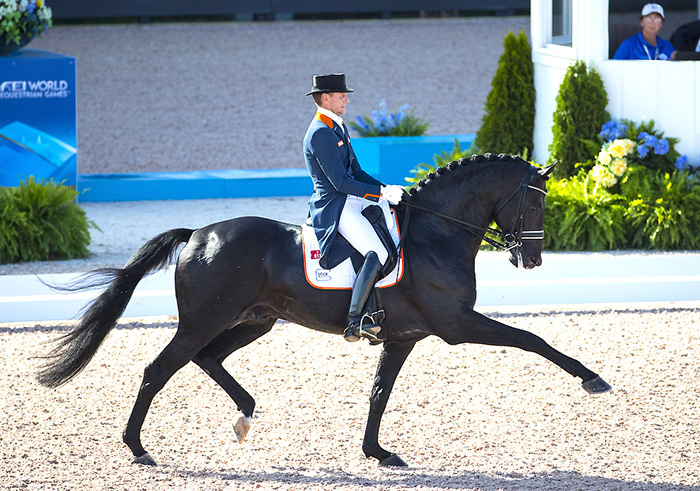
Zonik – oh so beautiful! Photo DigiShots
We have, while Francis was talking been watching a young horse test from Charlotte Dujardin’s WEG hope, Freestyle.
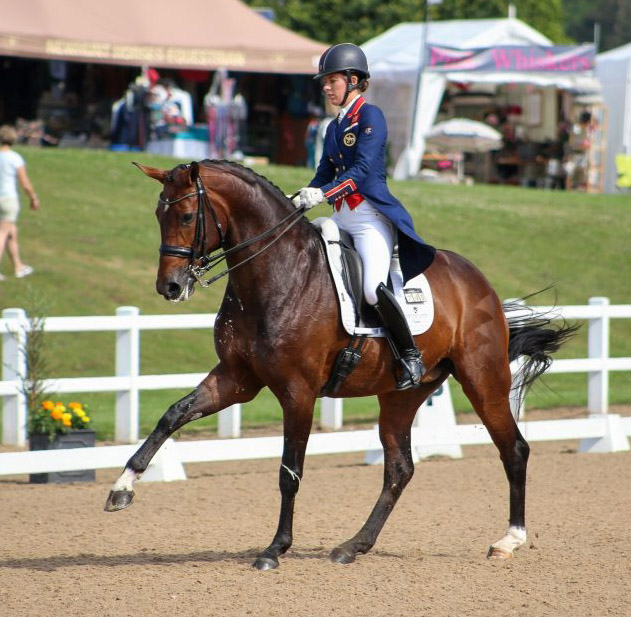
Charlotte and Freestyle
“See how quiet she sits in the changes, it is not just the change of lead, but the quality, that big reach, going forward… Her horse shows what we want, natural gaits, not the legs flying everywhere like an auction horse.”
Which I suppose means we’ll never see another World Young Horse champion like this…
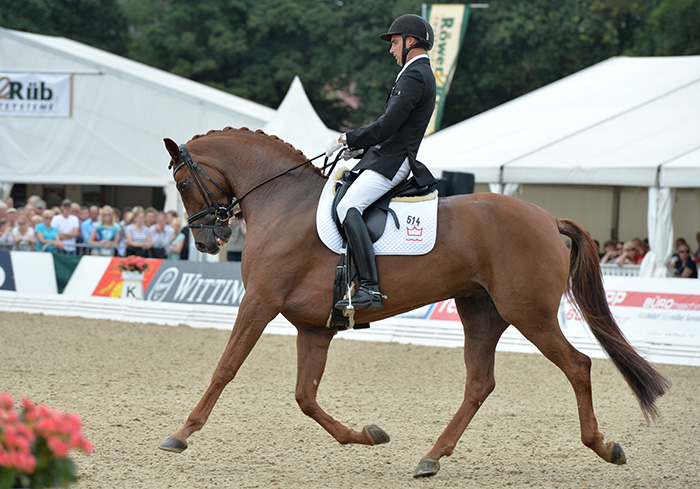
Although this horse didn’t actually win, she was second, and that was not so long ago, 2015 in fact…
While the dressage world has been celebrating the return of harmony, there is also concern that the young horse classes don’t become an end in themselves, that they should lead on to Grand Prix. Or as Francis put it: “We have to ask the question is the horse able to collect in all three gaits, this is specially important for the Grand Prix horse.”
next we look at two Young Horse stars who also became Grand Prix Olympic medal winners…
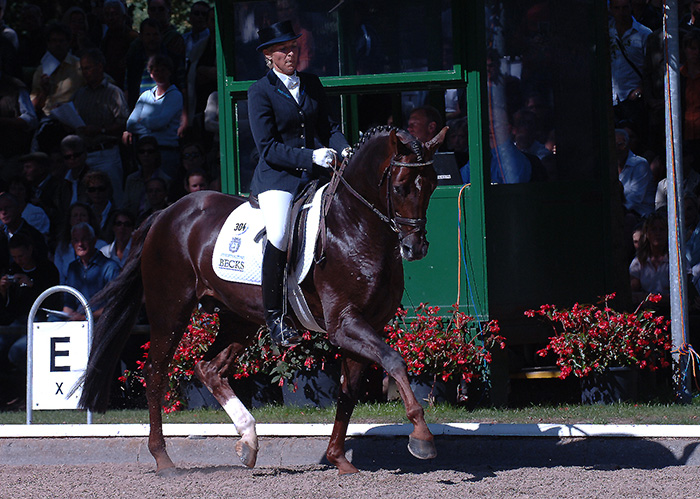
Damon Hill competing as a six-year-old with Ingrid Klimke
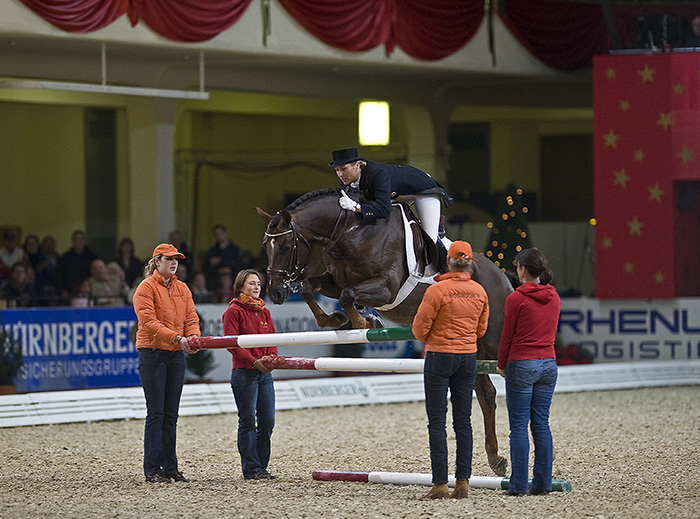
Winning the Prix St Georg for young horses – the Nürnberger Burg-Pokal – Ingrid decided to show how complete his training was at the presentation…
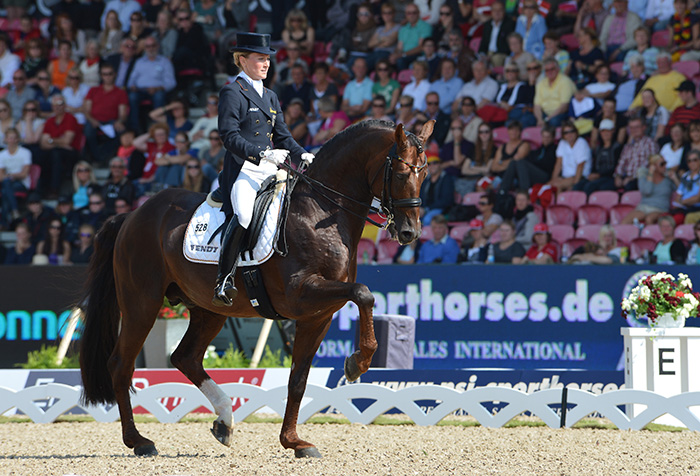
And winning Medals at Grand Prix level for Germany with Helen Langehanenberg
Obviously there have been some very fine Grand Prix horses that have been star young horses, Damon Hill and Desperados are perhaps the most notable, but there have also been an army of young horse stars that have disappeared without trace on reaching maturity.
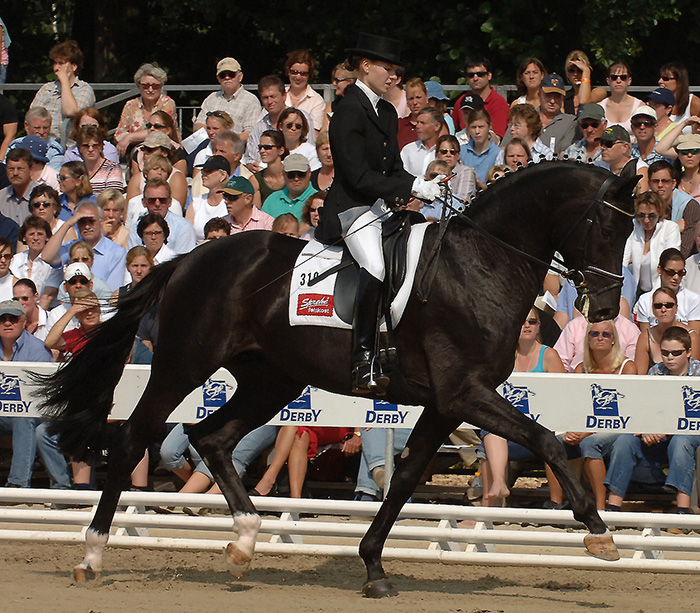
Desperados winning as a Four-Year-Old at the Bundeschampionat
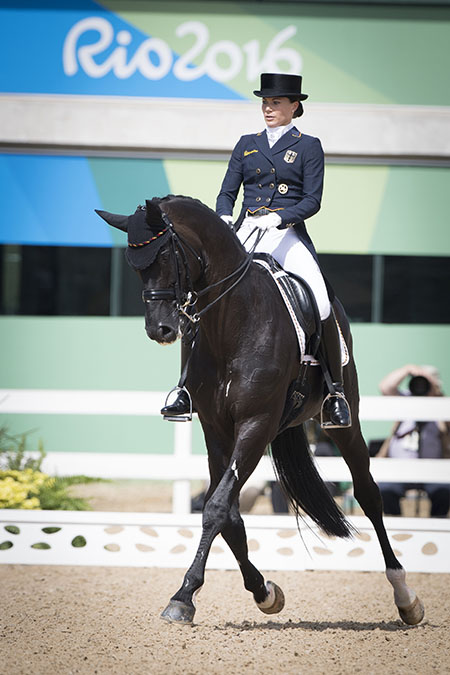
Desperados and Kristina Bröring-Sprehe, members of Rio Gold Medal team
It was comforting to hear Susie stress that the basis of the young horse classes must be the training scale:
“Regularity is Number 1 on the training scale. The horse is not made to carry a human, it is made to run, when we sit on him, the weight goes to the front. First we need regularity so the horse can find its own balance, then we need suppleness.”
Francis puts the emphasis on building a team: “Confidence is one of the most important things, that the horse trusts the rider, and step by step they make a combination that fits together.” Add of course, forward: “The first thing is to get the horse in front of the legs. The rider should never support the horse with his leg to keep it going. The horse should think forward with the rider, not running but forward, then they can work on rhythm, not over-riding but giving the horse confidence, even if they only get a few steps in complete balance.”

Francis also warned against what my first mentor in the art of judging dressage, the late Nick Williams, called pissage. “They talk about time in the air, and sometimes the horses are too much off the ground, like a slow motion trot.”
It’s an interesting observation since at the most recent World Champs in Ermelo, the judges awarded a ten for a trot that was decidedly passagey and the spokesman for the jury looked a trifle sheepish when quizzed on the matter.
Yet another element of the scale was introduced, “Suppleness,” Susie reminded us, “is so important for the back, the back is the key to suppleness – if the horse has a stiff back, how can he step under?”
Francis joined the chorus: “The back is the bridge in the horse, and it can only be there if the hind leg is really working. The rider has to influence the hind legs to build that bridge, otherwise it is a horse in three pieces, back, front and you somewhere in the middle.”
By this time we were watching one of the young horse stars of yesteryear, the strikingly marked Schickeria (Sir Donnerhall / Weltmeyer). The horse was purchased by Sissy Max-Theurer at the Münster Elite Sale, for a cool, €355,500, and sent to Helen Langehanenberg for training. The pair finished 15th in the World Young Horse 6 Year old Champs at Verden in 2011. Briefly re-appeared with the then Max-Theurer stable jockey Wibke Bruns for a 2nd in the St Georges and a 3rd in the Inter 2 in 2014, and thereupon disappeared. The chestnut had a truly wicked walk, and Francis encouraged the judges in the audience to go for the jugular – “Give 4 for an awful walk, show what you think as a judge, and then give a 9 when you see a really good one.”
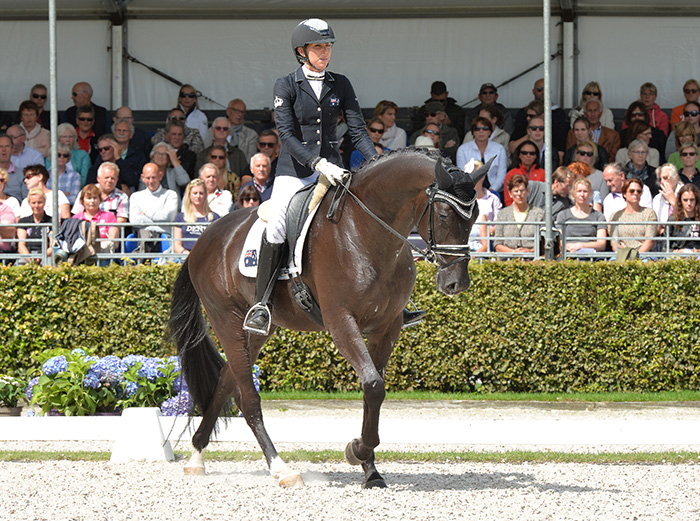
A walk for a ten at the 2017 World Young Horse Championships for Feodoro and Australia’s Simone Pearce
Although ever-tactful Susie suggests the judges should use the ‘sandwich’ technique: “Say something nice first, then you can be critical, then end on a positive note.”
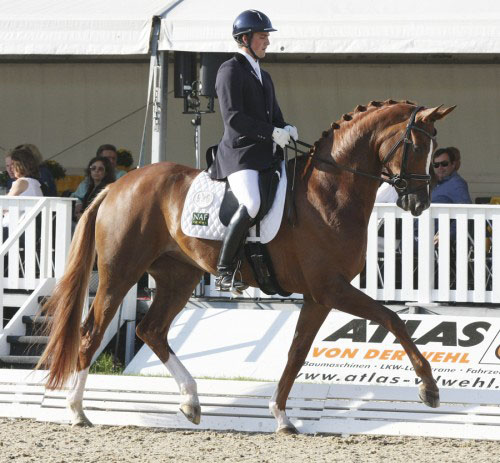
Woodlands Farouche and Michael Eilberg (Photo Kenneth Braddick/ Dressage News)
There was any number of positive things to say about Woodlands Farouche (Fürst Heinrich / Weltmeyer), which is not surprising since the horse has been a young horse superstar, taking out the World 5 and 6 year old titles in 2011/12. Her most recent international outing saw her win the Inter 1 and the St Georg at Aachen, with a pair of 76’s back in July 2016, but alas since then, she has been off the scene.
Susie comments that the walk is amazing, and that even if she did break in the medium trot, the submission mark goes down, “but if you were thinking 10, it goes to a 9.7 or 9.8, without that you could go for 10. The walk can be a 10, on that we all agree, over-track, activity, clear rhythm. ”
Francis highlights the canter: “Clear uphill tendency, it is so easy, I’m so impressed with the lengthening and coming back, 9.5 or higher. For prospective? For me 10 and I want to take her home.”
Susie sums up: “She is the picture of softness on both reins, the bend is supple on the voltés, stepping under to take the weight…”
The two judges also took time to explain the complexities of the new 7-year-old division of the young horse classes. “It’s new for us too,” Susie explained, “Now there’s not only paces, but also a technical assessment, but still the technical aspect is not judged as strictly as it would be in a normal dressage class.”
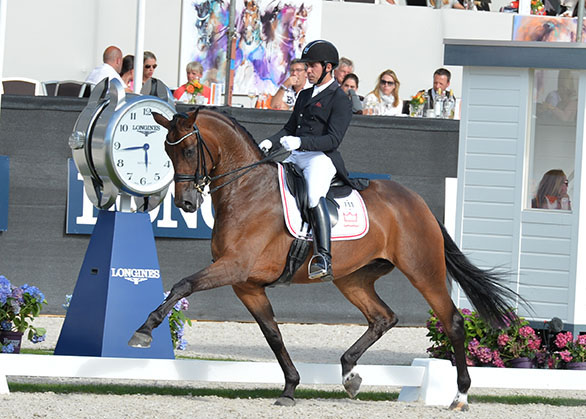
Winning the Seven Year Old class at the last World Champs – Fiontina and Severo
A point that Francis wanted to stress: “The judging is still more friendly than a regular test, it is still a young horse class. It can be confusing for the spectators, because many times the score from the technical judge can be 72 while the other judges are on 82, that can be a bit strange.”
Technical note from the FEI directives: Young horse classes for 7-year-old horses can be judged by a Ground Jury of three or five FEI Judges. For a Ground Jury of 3, the President sits at C and judges only the technical execution of the test. The second and third judges sit at E or B and judge only the quality of the horse. For a Ground Jury of 5, the President and second Judge sit at C and a third Ground Jury Member at E, judging only the quality of the horse by using a joint scoring method connected by headsets. The other two Ground Jury Members are individually judging only the technical execution of the test, one sitting at M and the other at B, but neither connected among each other nor connected to the judges at C and E. The quality of the horse and the technical execution of the test shall be weighted each with 50% towards the end result.
Next we talk to Susie
Later I had the chance to talk to both the young horse judges. I asked Susie to talk a little more about the issue of tension in young horse classes, that seems to me the major change in the last three or four years…
“That we want to see a more natural way of going? I’d agree with that, we really want to see the development of the horse’s natural paces. Often in the early days of Young Horse competition, the horses were ridden very forward before they really found their balance. We are breeding such beautiful horses now that I think our riders are understanding more that we want the softness, the elasticity and looseness, and that can only come when the horse is regular and balanced.”
How were we ever fooled that that tense, ‘spectacular’ style was nice?
“I think we’ve grown and developed, don’t you?”
I do, but even when that spectacular style was winning, I didn’t like it…
“It’s difficult because when it looks spectacular it can be impressive but now – and correctly so – there is a lot more emphasis on relaxation and the proper use of the back, that for me is very important. I think there is a lot more understanding now of the way we want the horses to develop.”
When we talk about the use of the back, for me, the minute I see the rider’s back come behind the vertical, that’s almost as clear a message as the horse’s nose coming behind the vertical, those riders are leaning back and pushing the horse into their pulling-back hands…
“Rather than swinging with the horse – yes, I agree and we saw that sometimes when we were judging at the weekend. It also tells you the horse is not in front of the leg. The top horses, their riders can sit there quietly, they don’t have to use the spur or over-use the aids. With those top combinations, the horse is willing, in front of the leg, stepping under the body to give themselves the balance, so they could balance. Horses weren’t made to be ridden were they?”
No, they were made to stand in a shady place and eat grass…
“So when we hop on them, we’ve got to teach them to re-balance, we have to gymnasticise them and according to the training scale. For me, the keys are regularity and relaxation, once you have those, then everything can follow and develop – but if your horse is not listening, and he is tense, how can you ask him to step under, how can you ask him to respond to your aids?”
You’ve judged Grand Prix at the highest level, and Young Horse at the highest level, which one gives you the buzz?
“Top Grand Prix, but it’s such a wonderful partnership at both levels, a good young horse, on the aids, he’s trusting, he’s still developing like Dorothee’s (Schneider) horse, Sezuan, the year before last, and really on the right way, the horse might not have found all its balance, but you can see the potential, so that is exciting to judge. But with Charlotte at Grand Prix with Valegro, and Freestyle, the new horse she has coming up, it is just a joy to see the harmony.”

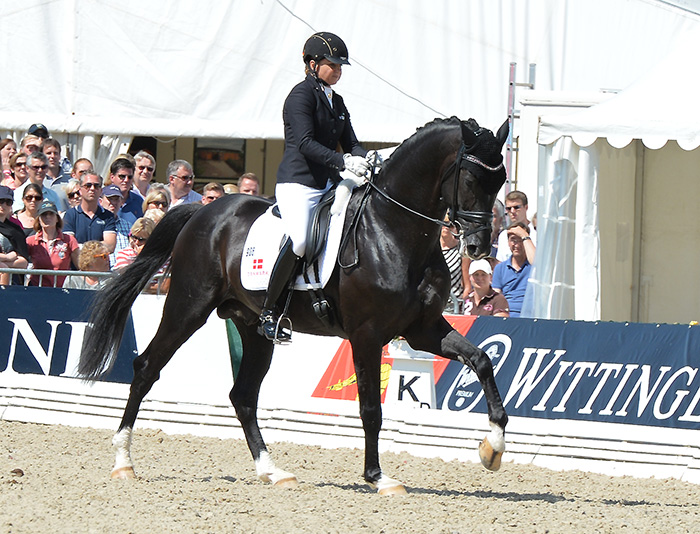
Dorothee and Sezuan at the World Young Horse Championships in Verden in 2016
Then it was Francis’ turn to be cross-examined:
Do you think young horse judging has changed and improved – we saw the slide earlier of the chestnut horse being ridden in the older way, rider leaning back, front legs flicking out in front, hind legs trailing behind – has it all got nicer?
“I think that is all-over in our sport. I think it is to do with the breeding and the quality of the horses. I remember when I was riding myself, you’d never try now to build that horse up to Grand Prix. The breeding around the world has improved so much, the horses are so much better in their body, in using their joints, than they were twenty, twenty-five years ago. That’s why it looks more in a natural way. Also looking back, the training has changed so much, we are more focused on suppleness now, MUCH more than ten or fifteen years ago. It has to swing, it has to look like happy athlete, an easy going horse. That’s what we are looking for…”
But even looking back, not fifteen or twenty years, but I think the big change in dressage came when Carl and Charlotte came out at the Europeans in Rotterdam in 2011 and showed how Grand Prix could be shown in lightness and harmony…
“With Carl and Charlotte you are naming two names to which you say – Wow! Everybody would love to have that feel in riding, it’s incredible. Of course it’s training, but I think when you train a rider, you can’t teach ‘feel’ – feel you have or you don’t have. You can improve your feel, but some are so talented that they have it just from nature, this feel in riding, and to be with the horse, almost always. I think we are all happy to see this, because we all want to see a happy athlete, an easy-going horse. It’s not the old days when they put a bit more pressure on the horse, we like to see it easy and soft, light.”
Do you think we are getting the right balance in the young horse classes, of not just looking at what is attractive now, but which horses will go on to the big sport?
“Of course not all the young horses will be a top talented Grand Prix horse because it is also the management around the horse. It is not only the horse, it’s a good way of training, sometimes riders don’t have the sponsor to stay at that level in the sport, because it is getting very expensive, so it is the whole management around. Will the horse stay sound with all the training? But I think recently we are getting more horses from the young horse competition into the highest level Grand Prix.”
Yet Valegro didn’t look great as a five-year-old…
“OH YES HE DID! I saw Valegro first when I was judging with Carl at an auction, they have a kind of competition at that auction for riders who bought at the auction, and Carl and I were judging it. And in the break before the auction, Charlotte was in the arena training, and I was sitting there like, oh my goodness, what a horse! That was the first time I saw him when he was five or six-years-old, so I could follow him all those years, up to the Olympic Games. I had the same experience with Totilas.

Totilas competing Prix St Georg with Edward Gal at Aachen in 2008
I first saw him in national Prix St Georges competition, about 2007, I saw this black pearl, wow what a horse, I couldn’t take my eyes off him. I think he had 77% in his first Prix St Georges. Later I got to judge him at the big shows and he was improving, improving. Those horses you will never forget in your life.”
Thank you Susie and Francis for sharing your knowledge with all of us…
Breed your own champion – go to www.ihb.com.au and see the great stallions they have on offer.

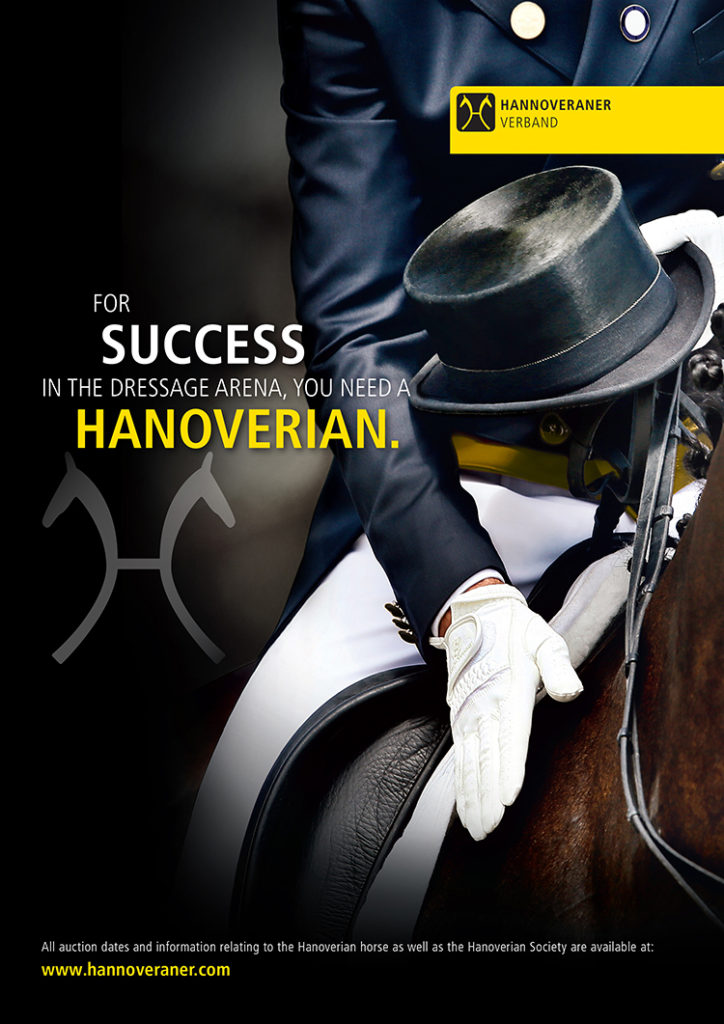
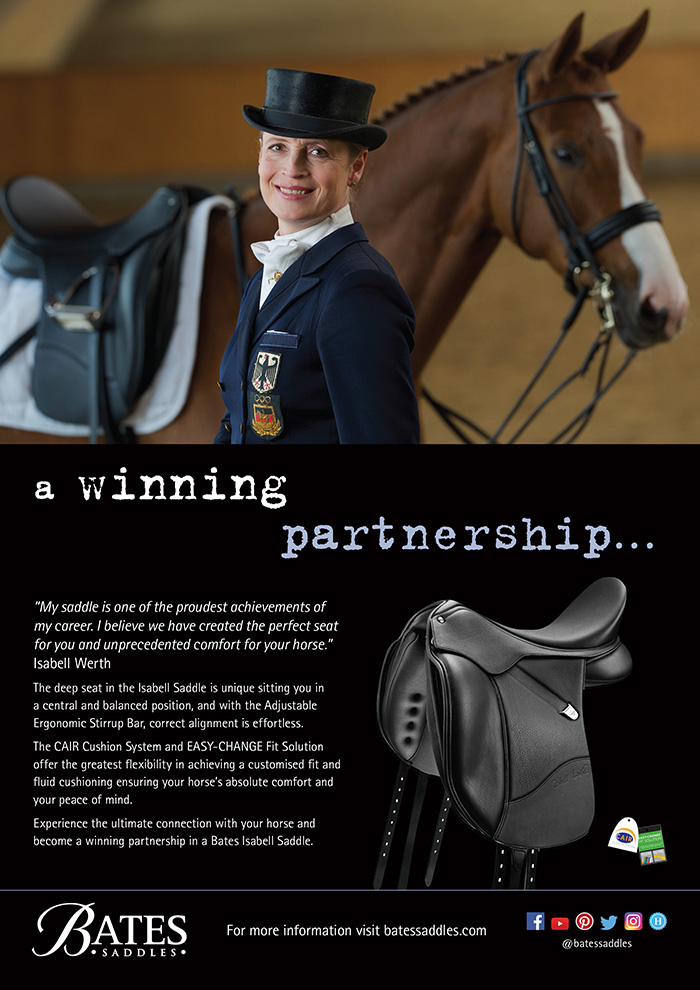
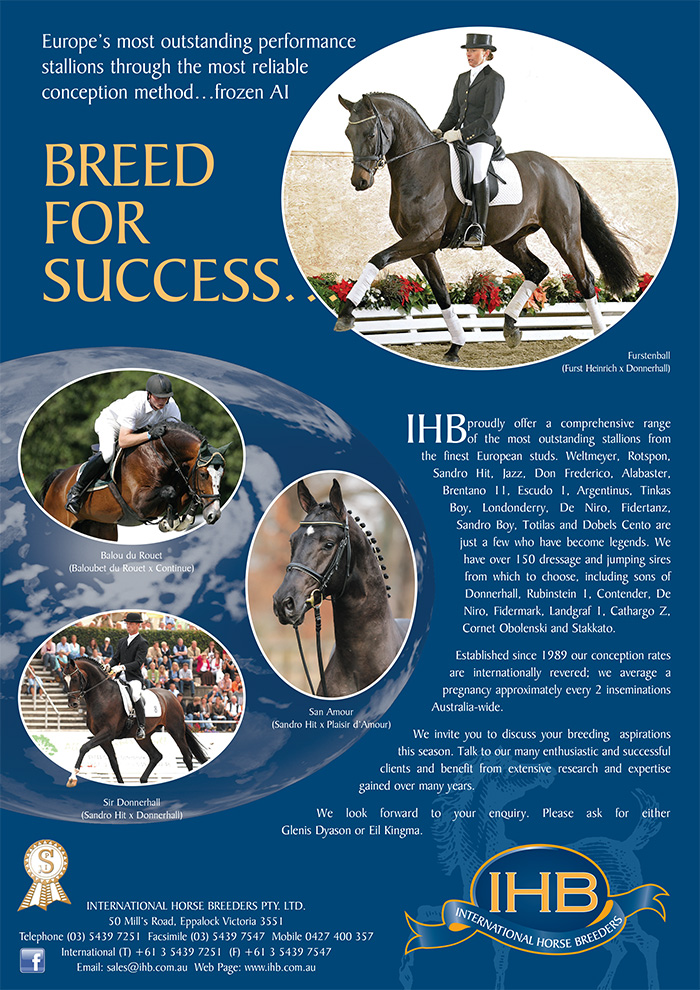
Such a good, and hopefully lasting look at Young horses classes. Some of the photos from the past are horrendous, and so against the natural way of going for a horse. We have the best role models to follow with Carl and Charlotte. Lets hope the message gets through.